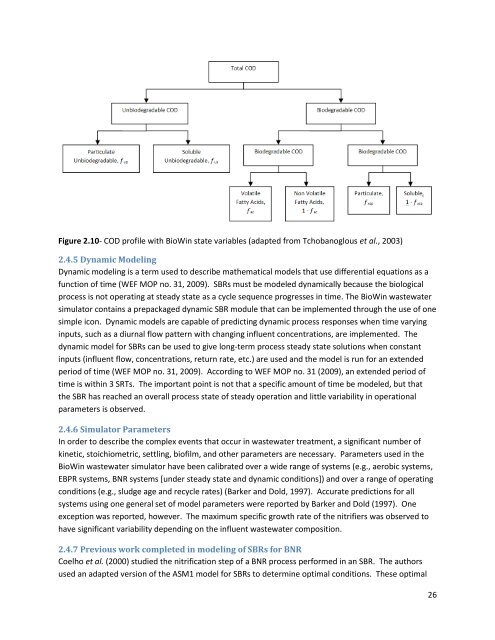E-Andrew Sindt Creative Component S11.pdf
E-Andrew Sindt Creative Component S11.pdf
E-Andrew Sindt Creative Component S11.pdf
You also want an ePaper? Increase the reach of your titles
YUMPU automatically turns print PDFs into web optimized ePapers that Google loves.
Figure 2.10- COD profile with BioWin state variables (adapted from Tchobanoglous et al., 2003)2.4.5 Dynamic ModelingDynamic modeling is a term used to describe mathematical models that use differential equations as afunction of time (WEF MOP no. 31, 2009). SBRs must be modeled dynamically because the biologicalprocess is not operating at steady state as a cycle sequence progresses in time. The BioWin wastewatersimulator contains a prepackaged dynamic SBR module that can be implemented through the use of onesimple icon. Dynamic models are capable of predicting dynamic process responses when time varyinginputs, such as a diurnal flow pattern with changing influent concentrations, are implemented. Thedynamic model for SBRs can be used to give long-term process steady state solutions when constantinputs (influent flow, concentrations, return rate, etc.) are used and the model is run for an extendedperiod of time (WEF MOP no. 31, 2009). According to WEF MOP no. 31 (2009), an extended period oftime is within 3 SRTs. The important point is not that a specific amount of time be modeled, but thatthe SBR has reached an overall process state of steady operation and little variability in operationalparameters is observed.2.4.6 Simulator ParametersIn order to describe the complex events that occur in wastewater treatment, a significant number ofkinetic, stoichiometric, settling, biofilm, and other parameters are necessary. Parameters used in theBioWin wastewater simulator have been calibrated over a wide range of systems (e.g., aerobic systems,EBPR systems, BNR systems [under steady state and dynamic conditions]) and over a range of operatingconditions (e.g., sludge age and recycle rates) (Barker and Dold, 1997). Accurate predictions for allsystems using one general set of model parameters were reported by Barker and Dold (1997). Oneexception was reported, however. The maximum specific growth rate of the nitrifiers was observed tohave significant variability depending on the influent wastewater composition.2.4.7 Previous work completed in modeling of SBRs for BNRCoelho et al. (2000) studied the nitrification step of a BNR process performed in an SBR. The authorsused an adapted version of the ASM1 model for SBRs to determine optimal conditions. These optimal26
















